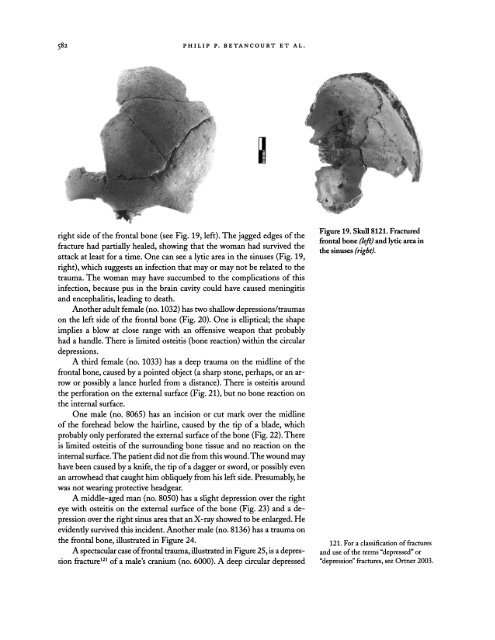Download - The American School of Classical Studies at Athens
Download - The American School of Classical Studies at Athens
Download - The American School of Classical Studies at Athens
You also want an ePaper? Increase the reach of your titles
YUMPU automatically turns print PDFs into web optimized ePapers that Google loves.
582<br />
PHILIP P. BETANCOURT ET AL.<br />
Figure 19. Skull 8121. Fractured<br />
right side <strong>of</strong> the frontal bone (see Fig. 19, left). <strong>The</strong> jagged edges <strong>of</strong> the<br />
frontal bone (left) and lytic area in<br />
fracture had partially healed, showing th<strong>at</strong> the woman had survived<br />
the sinuses (right).<br />
the<br />
<strong>at</strong>tack <strong>at</strong> least for a time. One can see a lytic area in the sinuses (Fig. 19,<br />
right), which suggests an infection th<strong>at</strong> may or may not be rel<strong>at</strong>ed to the<br />
trauma. <strong>The</strong> woman may have succumbed to the complic<strong>at</strong>ions <strong>of</strong> this<br />
infection, because pus in the brain cavity could have caused meningitis<br />
and encephalitis, leading to de<strong>at</strong>h.<br />
Another adult female (no. 1032) has two shallow depressions/traumas<br />
on the left side <strong>of</strong> the frontal bone (Fig. 20). One is elliptical; the shape<br />
implies a blow <strong>at</strong> close range with an <strong>of</strong>fensive weapon th<strong>at</strong> probably<br />
had a handle. <strong>The</strong>re is limited osteitis (bone reaction) within the circular<br />
depressions.<br />
A third female (no. 1033) has a deep trauma on the midline <strong>of</strong> the<br />
frontal bone, caused by a pointed object (a sharp stone, perhaps, or an arrow<br />
or possibly a lance hurled from a distance). <strong>The</strong>re is osteitis around<br />
the perfor<strong>at</strong>ion on the external surface (Fig. 21), but no bone reaction on<br />
the internal surface.<br />
One male (no. 8065) has an incision or cut mark over the midline<br />
<strong>of</strong> the forehead below the hairline, caused by the tip <strong>of</strong> a blade, which<br />
probably only perfor<strong>at</strong>ed the external surface <strong>of</strong> the bone (Fig. 22). <strong>The</strong>re<br />
is limited osteitis <strong>of</strong> the surrounding bone tissue and no reaction on the<br />
internal surface. <strong>The</strong> p<strong>at</strong>ient did not die from this wound. <strong>The</strong> wound may<br />
have been caused by a knife, the tip <strong>of</strong> a dagger or sword, or possibly even<br />
an arrowhead th<strong>at</strong> caught him obliquely from his left side. Presumably, he<br />
was not wearing protective headgear.<br />
A middle-aged man (no. 8050) has a slight depression over the right<br />
eye with osteitis on the external surface <strong>of</strong> the bone (Fig. 23) and a depression<br />
over the right sinus area th<strong>at</strong> an X-ray showed to be enlarged. He<br />
evidently survived this incident. Another male (no. 8136) has a trauma on<br />
the frontal bone, illustr<strong>at</strong>ed in Figure 24.<br />
121. For a classific<strong>at</strong>ion <strong>of</strong> fractures<br />
A spectacular case <strong>of</strong> frontal trauma, illustr<strong>at</strong>ed in Figure 25, is a depres- and use <strong>of</strong> the terms "depressed" or<br />
sion fracture121 <strong>of</strong> a male's cranium (no. 6000). A deep circular depressed "depression" fractures, see Ortner 2003.
















